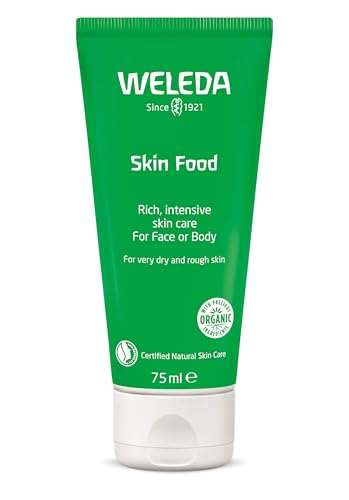
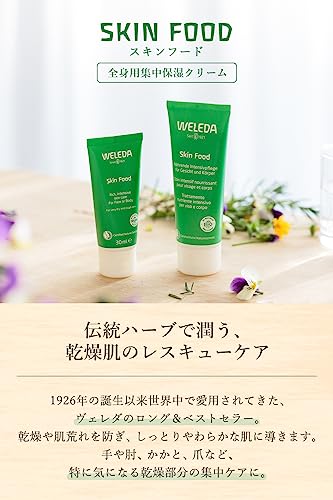
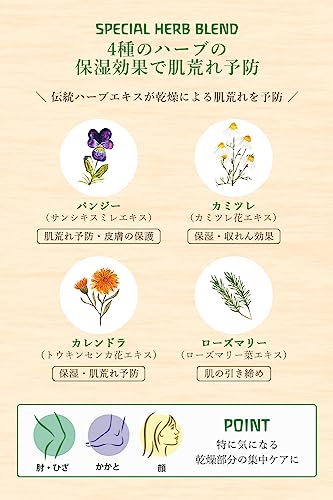
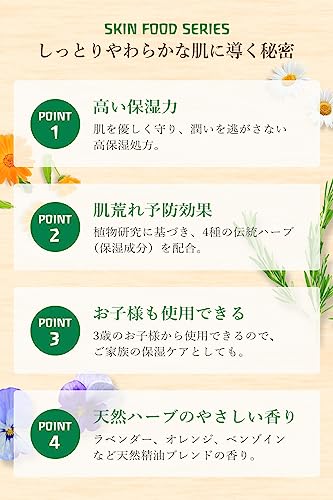
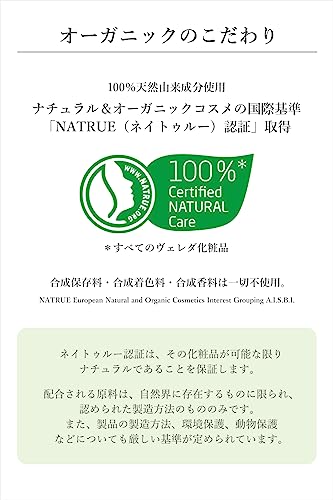
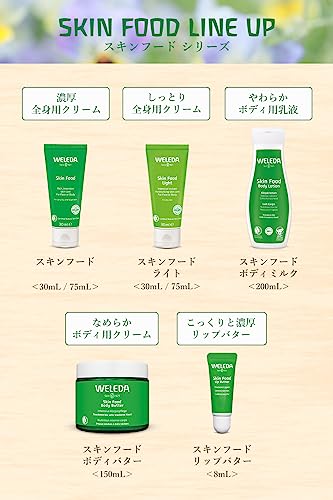

Weleda Skin Moisturizer - Intensive Hydration & Repair, Chamomile & Plant Extracts - 2.53 Fl Oz


Linalool
High RiskLinalool is a terpene commonly found in various plants, particularly in lavender and mint. It is primarily used in products for its fragrance and potential antimicrobial properties. Linalool is also utilized in formulations for its ability to enhance the sensory experience of personal care and household products.
Sustai Insights
Linalool offers functional benefits as a naturally occurring fragrance component and may exhibit antimicrobial properties. However, it presents high allergenic potential, with concerns about skin irritation and sensitization. Environmental risks include contamination issues, though it is not classified as a persistent pollutant. Regulatory bodies have noted the need for careful handling due to its allergenic nature. Overall, despite some beneficial attributes, the ingredient carries a high risk profile, warranting cautious use and consideration of safer alternatives.
Fragrance
High RiskFragrance refers to a mixture of aromatic compounds used in products to provide scent. It is commonly listed as 'fragrance' or 'parfum' on product labels and can serve various functions, including enhancing user experience and masking undesirable odors.
Sustai Insights
Fragrance offers functional benefits by improving product appeal; however, it poses significant health risks, notably a high likelihood of causing allergies and allergic contact dermatitis. Environmental risks include potential pollution and endocrine disruption, though its overall carcinogenicity is low. Regulatory bodies have noted concerns regarding its use, leading to a high-risk classification. Safe usage practices should be observed, and alternatives such as natural essential oils are recommended for those sensitive to synthetic fragrances.
Geraniol
High RiskGeraniol is a naturally occurring scent ingredient commonly found in essential oils from plants such as geraniums and lemongrass. It is primarily used for its pleasant floral aroma in perfumes, cosmetics, and household products.
Sustai Insights
Geraniol serves as a fragrance component and offers a natural option for scenting products. However, it has a high allergenic potential and may cause skin irritation in sensitive individuals. While it is considered low risk for carcinogenicity and reproductive toxicity, regulatory bodies have placed restrictions on its use due to allergenic concerns. Overall, the assessment reflects a high-risk level, particularly for those prone to allergies, highlighting the need for caution in its application.
Coumarin
High RiskCoumarin is a naturally occurring and synthetic compound found in many plants. It is commonly used in fragrances, flavorings, and as a potential therapeutic agent due to its aromatic properties. Coumarin has applications in cosmetics and personal care products, contributing to their scent and stability.
Sustai Insights
Coumarin offers functional benefits as a fragrance and flavoring agent, with potential health benefits in certain therapeutic contexts. However, it is associated with high allergenic potential and may pose risks such as skin irritation. Environmental concerns include its classification as a pollutant, with possible bioaccumulation effects. Regulatory bodies have restricted its use in specific products, indicating a moderate to high risk overall. Safe usage practices are advised, and alternatives like natural essential oils could be considered.
Geranial
Medium RiskGeranial is a naturally occurring compound found in essential oils, primarily derived from lemongrass. It is commonly used in fragrances and flavoring due to its lemon-like scent. Geranial acts as a fragrance component and is often included in personal care and cosmetic products.
Sustai Insights
Geranial offers functional benefits as a fragrance enhancer in various products. While it is generally well-tolerated, it has a moderate allergenic potential, and caution is advised for sensitive individuals. Environmentally, it does not appear to be bioaccumulative, but its use is restricted in some verified products. Overall, the risk level is assessed as medium, suggesting that while it is useful, careful consideration of exposure is warranted.
Limonene
Medium RiskLimonene is a scent ingredient and solvent naturally found in citrus fruits, commonly used in personal care and cleaning products for its fragrant properties. It serves as a flavoring agent and enhances the overall sensory experience of products.
Sustai Insights
Limonene offers functional benefits such as acting as a solvent and fragrance enhancer. However, it carries a high allergenic potential, which can trigger skin or respiratory sensitivities in some individuals. Environmental concerns include moderate persistence and bioaccumulation, along with potential ecotoxicity. Regulatory restrictions necessitate verification in products containing this ingredient. Overall, the risk level is assessed as medium, emphasizing the importance of cautious use, particularly for sensitive populations. Safer alternatives may be considered to mitigate these risks.
Glyceryl Linoleate
Medium RiskGlyceryl linoleate is a monoester of glycerin and linoleic acid. It acts as an emulsifier and skin conditioning agent, commonly used in cosmetic and personal care products to enhance texture and stability.
Sustai Insights
Glyceryl linoleate provides functional benefits as an emulsifier and skin conditioner, contributing to product stability and user experience. It is generally regarded as low risk for health concerns, including carcinogenicity and allergenic potential. However, there are moderate use restrictions and some irritation potential. Environmentally, it poses low risks, as it is not considered a pollutant or bioaccumulative. Regulatory bodies do not list it as hazardous, but users should still practice safe usage. While alternatives exist, glyceryl linoleate remains a viable option for formulation needs, leading to an overall medium risk assessment.
Rosmarinus Officinalis (Rosemary) Leaf Extract
Medium RiskRosemary leaf extract is produced from the leaves of the Rosmarinus officinalis plant. It is commonly used in cosmetic formulations for its potential antioxidant properties and fragrance. The extract may also contribute to the preservation of products due to its antimicrobial characteristics.
Sustai Insights
Rosemary leaf extract offers functional benefits such as antioxidant and antimicrobial properties, which can enhance product stability and shelf-life. It is generally considered low risk for carcinogenicity and reproductive toxicity, but it carries a moderate potential for allergic reactions. Environmentally, it poses low risk with no significant pollutant or bioaccumulation concerns. Regulatory bodies have not placed significant restrictions on its use, although some verified products cannot contain certain concentrations. Overall, the ingredient's risk level is medium, necessitating careful usage practices to mitigate allergic responses.
Helianthus Annuus (Sunflower) Seed
Low RiskHelianthus annuus (sunflower) seed is derived from the seeds of the sunflower plant and is commonly used in various cosmetic and personal care products. It serves primarily as an emollient and skin conditioning agent, providing moisture and enhancing the texture of formulations.
Sustai Insights
Helianthus annuus (sunflower) seed offers functional benefits, including skin conditioning and moisturizing properties, while being sustainably sourced and biodegradable. Health risks are minimal, with low concerns for carcinogenicity, allergies, and reproductive toxicity. Environmentally, it presents low risks of pollution or bioaccumulation. Regulatory assessments indicate no current restrictions. Overall, it is considered a low-risk ingredient, and safe usage practices should be maintained. Alternative ingredients may include other plant-based oils, but the sunflower seed oil remains a viable option.
Water
Low RiskWater is a clear, colorless liquid essential for various biological processes. It serves as a solvent in formulations, facilitating the dissolution of other ingredients and enhancing product texture and application. Additionally, water plays a crucial role in hydration and is a key component in many cosmetic and personal care products.
Sustai Insights
Water is an effective solvent and hydrator, contributing to the texture and efficacy of formulations. It is biodegradable and generally regarded as safe, with low concerns regarding carcinogenicity, allergies, and reproductive toxicity. However, excessive water usage can lead to environmental concerns, particularly regarding resource depletion. Regulatory bodies do not impose restrictions on water use in cosmetics. Overall, the risks associated with water are low, making it a safe and essential ingredient.
Hydrolyzed Beeswax
Low RiskHydrolyzed beeswax is a hydrolysate of beeswax, commonly used in cosmetic and personal care formulations. It functions primarily as an emulsifier and thickening agent, contributing to the texture and stability of products.
Sustai Insights
Hydrolyzed beeswax offers functional benefits as an effective emulsifier and thickener, enhancing product texture. It is biodegradable and can be sustainably sourced. Health risks are low, with minimal concerns regarding carcinogenicity, allergenic potential, or reproductive toxicity; however, contamination concerns are noted. Environmental risks are also low, with no significant pollutants or bioaccumulation effects reported. Regulatory bodies do not currently list any restrictions for this ingredient, leading to an overall low risk assessment. Safe usage practices should be followed, and alternatives like plant-based waxes may be considered.
Anhydrous Liquid Lanolin
Low RiskAnhydrous liquid lanolin is a refined derivative of the fat-like substance secreted by sheep's wool. It serves primarily as a moisturizer and emollient in various cosmetic and personal care products, providing a protective barrier to the skin.
Sustai Insights
Anhydrous liquid lanolin offers functional benefits as a moisturizer, helping to maintain skin hydration and barrier function. It is generally regarded as low risk for cancer, developmental toxicity, and use restrictions, though it may pose low to moderate allergenic risks for sensitive individuals. Environmentally, it is not considered a significant pollutant or bioaccumulative. Regulatory assessments confirm its safety within established limits. For those with allergies, alternatives like plant-based oils may be considered. Overall, the risk associated with this ingredient is low.
Viola Tricolor Extract
Low RiskViola tricolor extract is derived from the pansy plant, known for its use in traditional medicine. It is often included in cosmetic and skincare formulations for its potential soothing properties and is sometimes used in herbal remedies.
Sustai Insights
Viola tricolor extract offers functional benefits such as skin soothing and potential anti-inflammatory effects. It is generally considered low risk for health concerns including carcinogenicity, allergies, and reproductive toxicity. Environmentally, it poses low risks regarding pollution and bioaccumulation. Regulatory assessments indicate no current restrictions. For safe usage, it is recommended to monitor for individual sensitivities. Alternative extracts with similar soothing properties may include chamomile or calendula. Overall, this ingredient can be assessed as low risk.
Chamomilla Recutita (Matricaria) Flower Extract
Low RiskChamomilla recutita (Matricaria) flower extract is derived from the flower of the chamomile plant. It is commonly used in cosmetic products for its soothing properties and as an anti-inflammatory agent. This extract is valued for its potential to calm skin irritations and enhance overall skin appearance.
Sustai Insights
Chamomilla recutita (Matricaria) flower extract is recognized for its soothing and anti-inflammatory benefits, making it effective in skincare formulations. It is sustainably sourced and not associated with significant health risks, such as carcinogenicity or allergenic potential, resulting in a low-risk profile. Environmental concerns are minimal as it does not contribute significantly to pollution. Regulatory bodies impose few restrictions on its use, further supporting its safety. However, users should practice standard safety measures, particularly if they have known sensitivities. Overall, it is a low-risk ingredient with favorable attributes.
Cholesterol
Low RiskCholesterol is a mono-unsaturated, secondary alcohol that serves as a crucial component of cell membranes and a precursor for steroid hormones and bile acids. It is naturally produced in the body and is also obtained from dietary sources, primarily animal products.
Sustai Insights
Cholesterol plays a vital role in various biological functions, including membrane fluidity and hormone production. While generally considered low risk for cancer, allergies, and reproductive toxicity, it has moderate concerns regarding persistence and bioaccumulation in the environment. Regulatory bodies do not impose significant restrictions on cholesterol. Safe usage practices include moderation in dietary intake, as excessive cholesterol can lead to cardiovascular issues. Overall, the risk assessment indicates a low risk associated with cholesterol.
Corylus (Hazelnut) Oil
Low RiskCorylus (hazelnut) oil is derived from the nuts of the hazel tree. It is primarily used in cosmetic and skincare products for its emollient properties, providing moisture and enhancing skin texture. The oil is rich in fatty acids and vitamins, contributing to its function as a skin conditioning agent.
Sustai Insights
Corylus (hazelnut) oil offers functional benefits as a moisturizer and skin conditioner while being biodegradable and potentially sustainably sourced. Health risks are low, with minimal concerns related to carcinogenicity, allergenic potential, or reproductive toxicity. Environmental impacts are also low, with no known bioaccumulation issues. Regulatory status shows no restrictions. Overall, the ingredient is assessed as low risk, with safe usage practices recommended and no significant alternatives noted.
Helianthus Annuus (Sunflower) Seed
Low RiskHelianthus annuus (sunflower) seed is derived from the seeds of the sunflower plant and is commonly used in various cosmetic and personal care products. It serves primarily as an emollient and skin conditioning agent, providing moisture and enhancing the texture of formulations.
Sustai Insights
Helianthus annuus (sunflower) seed offers functional benefits, including skin conditioning and moisturizing properties, while being sustainably sourced and biodegradable. Health risks are minimal, with low concerns for carcinogenicity, allergies, and reproductive toxicity. Environmentally, it presents low risks of pollution or bioaccumulation. Regulatory assessments indicate no current restrictions. Overall, it is considered a low-risk ingredient, and safe usage practices should be maintained. Alternative ingredients may include other plant-based oils, but the sunflower seed oil remains a viable option.
Water
Low RiskWater is a clear, colorless liquid essential for various biological processes. It serves as a solvent in formulations, facilitating the dissolution of other ingredients and enhancing product texture and application. Additionally, water plays a crucial role in hydration and is a key component in many cosmetic and personal care products.
Sustai Insights
Water is an effective solvent and hydrator, contributing to the texture and efficacy of formulations. It is biodegradable and generally regarded as safe, with low concerns regarding carcinogenicity, allergies, and reproductive toxicity. However, excessive water usage can lead to environmental concerns, particularly regarding resource depletion. Regulatory bodies do not impose restrictions on water use in cosmetics. Overall, the risks associated with water are low, making it a safe and essential ingredient.
Hydrolyzed Beeswax
Low RiskHydrolyzed beeswax is a hydrolysate of beeswax, commonly used in cosmetic and personal care formulations. It functions primarily as an emulsifier and thickening agent, contributing to the texture and stability of products.
Sustai Insights
Hydrolyzed beeswax offers functional benefits as an effective emulsifier and thickener, enhancing product texture. It is biodegradable and can be sustainably sourced. Health risks are low, with minimal concerns regarding carcinogenicity, allergenic potential, or reproductive toxicity; however, contamination concerns are noted. Environmental risks are also low, with no significant pollutants or bioaccumulation effects reported. Regulatory bodies do not currently list any restrictions for this ingredient, leading to an overall low risk assessment. Safe usage practices should be followed, and alternatives like plant-based waxes may be considered.
Geranial
Medium RiskGeranial is a naturally occurring compound found in essential oils, primarily derived from lemongrass. It is commonly used in fragrances and flavoring due to its lemon-like scent. Geranial acts as a fragrance component and is often included in personal care and cosmetic products.
Sustai Insights
Geranial offers functional benefits as a fragrance enhancer in various products. While it is generally well-tolerated, it has a moderate allergenic potential, and caution is advised for sensitive individuals. Environmentally, it does not appear to be bioaccumulative, but its use is restricted in some verified products. Overall, the risk level is assessed as medium, suggesting that while it is useful, careful consideration of exposure is warranted.
Limonene
Medium RiskLimonene is a scent ingredient and solvent naturally found in citrus fruits, commonly used in personal care and cleaning products for its fragrant properties. It serves as a flavoring agent and enhances the overall sensory experience of products.
Sustai Insights
Limonene offers functional benefits such as acting as a solvent and fragrance enhancer. However, it carries a high allergenic potential, which can trigger skin or respiratory sensitivities in some individuals. Environmental concerns include moderate persistence and bioaccumulation, along with potential ecotoxicity. Regulatory restrictions necessitate verification in products containing this ingredient. Overall, the risk level is assessed as medium, emphasizing the importance of cautious use, particularly for sensitive populations. Safer alternatives may be considered to mitigate these risks.
Glyceryl Linoleate
Medium RiskGlyceryl linoleate is a monoester of glycerin and linoleic acid. It acts as an emulsifier and skin conditioning agent, commonly used in cosmetic and personal care products to enhance texture and stability.
Sustai Insights
Glyceryl linoleate provides functional benefits as an emulsifier and skin conditioner, contributing to product stability and user experience. It is generally regarded as low risk for health concerns, including carcinogenicity and allergenic potential. However, there are moderate use restrictions and some irritation potential. Environmentally, it poses low risks, as it is not considered a pollutant or bioaccumulative. Regulatory bodies do not list it as hazardous, but users should still practice safe usage. While alternatives exist, glyceryl linoleate remains a viable option for formulation needs, leading to an overall medium risk assessment.
Linalool
High RiskLinalool is a terpene commonly found in various plants, particularly in lavender and mint. It is primarily used in products for its fragrance and potential antimicrobial properties. Linalool is also utilized in formulations for its ability to enhance the sensory experience of personal care and household products.
Sustai Insights
Linalool offers functional benefits as a naturally occurring fragrance component and may exhibit antimicrobial properties. However, it presents high allergenic potential, with concerns about skin irritation and sensitization. Environmental risks include contamination issues, though it is not classified as a persistent pollutant. Regulatory bodies have noted the need for careful handling due to its allergenic nature. Overall, despite some beneficial attributes, the ingredient carries a high risk profile, warranting cautious use and consideration of safer alternatives.
Anhydrous Liquid Lanolin
Low RiskAnhydrous liquid lanolin is a refined derivative of the fat-like substance secreted by sheep's wool. It serves primarily as a moisturizer and emollient in various cosmetic and personal care products, providing a protective barrier to the skin.
Sustai Insights
Anhydrous liquid lanolin offers functional benefits as a moisturizer, helping to maintain skin hydration and barrier function. It is generally regarded as low risk for cancer, developmental toxicity, and use restrictions, though it may pose low to moderate allergenic risks for sensitive individuals. Environmentally, it is not considered a significant pollutant or bioaccumulative. Regulatory assessments confirm its safety within established limits. For those with allergies, alternatives like plant-based oils may be considered. Overall, the risk associated with this ingredient is low.
Fragrance
High RiskFragrance refers to a mixture of aromatic compounds used in products to provide scent. It is commonly listed as 'fragrance' or 'parfum' on product labels and can serve various functions, including enhancing user experience and masking undesirable odors.
Sustai Insights
Fragrance offers functional benefits by improving product appeal; however, it poses significant health risks, notably a high likelihood of causing allergies and allergic contact dermatitis. Environmental risks include potential pollution and endocrine disruption, though its overall carcinogenicity is low. Regulatory bodies have noted concerns regarding its use, leading to a high-risk classification. Safe usage practices should be observed, and alternatives such as natural essential oils are recommended for those sensitive to synthetic fragrances.
Viola Tricolor Extract
Low RiskViola tricolor extract is derived from the pansy plant, known for its use in traditional medicine. It is often included in cosmetic and skincare formulations for its potential soothing properties and is sometimes used in herbal remedies.
Sustai Insights
Viola tricolor extract offers functional benefits such as skin soothing and potential anti-inflammatory effects. It is generally considered low risk for health concerns including carcinogenicity, allergies, and reproductive toxicity. Environmentally, it poses low risks regarding pollution and bioaccumulation. Regulatory assessments indicate no current restrictions. For safe usage, it is recommended to monitor for individual sensitivities. Alternative extracts with similar soothing properties may include chamomile or calendula. Overall, this ingredient can be assessed as low risk.
Geraniol
High RiskGeraniol is a naturally occurring scent ingredient commonly found in essential oils from plants such as geraniums and lemongrass. It is primarily used for its pleasant floral aroma in perfumes, cosmetics, and household products.
Sustai Insights
Geraniol serves as a fragrance component and offers a natural option for scenting products. However, it has a high allergenic potential and may cause skin irritation in sensitive individuals. While it is considered low risk for carcinogenicity and reproductive toxicity, regulatory bodies have placed restrictions on its use due to allergenic concerns. Overall, the assessment reflects a high-risk level, particularly for those prone to allergies, highlighting the need for caution in its application.
Chamomilla Recutita (Matricaria) Flower Extract
Low RiskChamomilla recutita (Matricaria) flower extract is derived from the flower of the chamomile plant. It is commonly used in cosmetic products for its soothing properties and as an anti-inflammatory agent. This extract is valued for its potential to calm skin irritations and enhance overall skin appearance.
Sustai Insights
Chamomilla recutita (Matricaria) flower extract is recognized for its soothing and anti-inflammatory benefits, making it effective in skincare formulations. It is sustainably sourced and not associated with significant health risks, such as carcinogenicity or allergenic potential, resulting in a low-risk profile. Environmental concerns are minimal as it does not contribute significantly to pollution. Regulatory bodies impose few restrictions on its use, further supporting its safety. However, users should practice standard safety measures, particularly if they have known sensitivities. Overall, it is a low-risk ingredient with favorable attributes.
Cholesterol
Low RiskCholesterol is a mono-unsaturated, secondary alcohol that serves as a crucial component of cell membranes and a precursor for steroid hormones and bile acids. It is naturally produced in the body and is also obtained from dietary sources, primarily animal products.
Sustai Insights
Cholesterol plays a vital role in various biological functions, including membrane fluidity and hormone production. While generally considered low risk for cancer, allergies, and reproductive toxicity, it has moderate concerns regarding persistence and bioaccumulation in the environment. Regulatory bodies do not impose significant restrictions on cholesterol. Safe usage practices include moderation in dietary intake, as excessive cholesterol can lead to cardiovascular issues. Overall, the risk assessment indicates a low risk associated with cholesterol.
Corylus (Hazelnut) Oil
Low RiskCorylus (hazelnut) oil is derived from the nuts of the hazel tree. It is primarily used in cosmetic and skincare products for its emollient properties, providing moisture and enhancing skin texture. The oil is rich in fatty acids and vitamins, contributing to its function as a skin conditioning agent.
Sustai Insights
Corylus (hazelnut) oil offers functional benefits as a moisturizer and skin conditioner while being biodegradable and potentially sustainably sourced. Health risks are low, with minimal concerns related to carcinogenicity, allergenic potential, or reproductive toxicity. Environmental impacts are also low, with no known bioaccumulation issues. Regulatory status shows no restrictions. Overall, the ingredient is assessed as low risk, with safe usage practices recommended and no significant alternatives noted.
Coumarin
High RiskCoumarin is a naturally occurring and synthetic compound found in many plants. It is commonly used in fragrances, flavorings, and as a potential therapeutic agent due to its aromatic properties. Coumarin has applications in cosmetics and personal care products, contributing to their scent and stability.
Sustai Insights
Coumarin offers functional benefits as a fragrance and flavoring agent, with potential health benefits in certain therapeutic contexts. However, it is associated with high allergenic potential and may pose risks such as skin irritation. Environmental concerns include its classification as a pollutant, with possible bioaccumulation effects. Regulatory bodies have restricted its use in specific products, indicating a moderate to high risk overall. Safe usage practices are advised, and alternatives like natural essential oils could be considered.
Rosmarinus Officinalis (Rosemary) Leaf Extract
Medium RiskRosemary leaf extract is produced from the leaves of the Rosmarinus officinalis plant. It is commonly used in cosmetic formulations for its potential antioxidant properties and fragrance. The extract may also contribute to the preservation of products due to its antimicrobial characteristics.
Sustai Insights
Rosemary leaf extract offers functional benefits such as antioxidant and antimicrobial properties, which can enhance product stability and shelf-life. It is generally considered low risk for carcinogenicity and reproductive toxicity, but it carries a moderate potential for allergic reactions. Environmentally, it poses low risk with no significant pollutant or bioaccumulation concerns. Regulatory bodies have not placed significant restrictions on its use, although some verified products cannot contain certain concentrations. Overall, the ingredient's risk level is medium, necessitating careful usage practices to mitigate allergic responses.
Experience the soothing power of Weleda Italia's Chamomile Skin Moisturizer, a versatile solution for dry, cracked skin. This intensive repair cream is designed for both face and body, offering deep hydration and protection against environmental stressors.
- Intensive Hydration: This cream deeply nourishes and hydrates the skin, promoting a soft and supple feel.
- Natural Ingredients: Enriched with biological extracts from chamomile, wild pansy, and calendula, it effectively soothes irritations and rejuvenates the skin.
- Dermatologically Tested: Free from preservatives, dyes, and synthetic fragrances, ensuring a gentle experience for all skin types.
- Versatile Use: Ideal not only as a moisturizer but also as a revitalizing mask or a repairing lip balm, providing multiple skincare solutions in one product.
- Easy Application: Simply cleanse, apply, and massage gently into the skin for optimal absorption, making it a seamless addition to your daily skincare routine.
Subscribe & Save with Sustai
- Best Price Guarantee: Always enjoy the lowest prices on sustainable home essentials.
- No Surprises: We’ll notify you before shipping. No hidden fees, ever.
- You’re in Charge: Change, pause, or cancel your subscription anytime with ease.
- Eco-Friendly Deliveries: Our grouped shipments mean less packaging and lower emissions.
Join us on a sustainable journey. Special offers for a limited time! Prices and promotions may change.
Recommended Products
Experience the soothing power of Weleda Italia's Chamomile Skin Moisturizer, a versatile solution for dry, cracked skin. This intensive repair cream is designed for both face and body, offering deep hydration and protection against environmental stressors.
- Intensive Hydration: This cream deeply nourishes and hydrates the skin, promoting a soft and supple feel.
- Natural Ingredients: Enriched with biological extracts from chamomile, wild pansy, and calendula, it effectively soothes irritations and rejuvenates the skin.
- Dermatologically Tested: Free from preservatives, dyes, and synthetic fragrances, ensuring a gentle experience for all skin types.
- Versatile Use: Ideal not only as a moisturizer but also as a revitalizing mask or a repairing lip balm, providing multiple skincare solutions in one product.
- Easy Application: Simply cleanse, apply, and massage gently into the skin for optimal absorption, making it a seamless addition to your daily skincare routine.

You can have at most 2 Sustainable Steals products in your cart
Customer Reviews
Customers’ View
Customers appreciate the effectiveness and natural formulation of Weleda's Face Moisturizer with Chamomile. Many users report significant improvements in skin quality, describing it as the 'best face cream ever' and noting its suitability for various skin types, especially dry skin. Common praises highlight the product's deep hydration properties, with several customers mentioning that it effectively seals in moisture without feeling greasy. Additionally, the gentle, plant-based ingredients are valued by health-conscious consumers seeking safe skincare options. Overall, this moisturizer is recognized for its ability to nourish and protect the skin, aligning well with eco-friendly and health-oriented values.
AI-generated from the text of customer reviewsThis product has no reviews yet.




